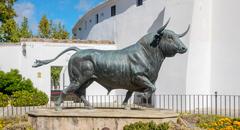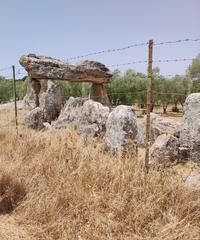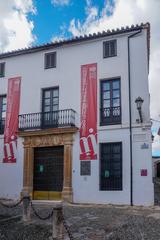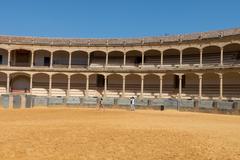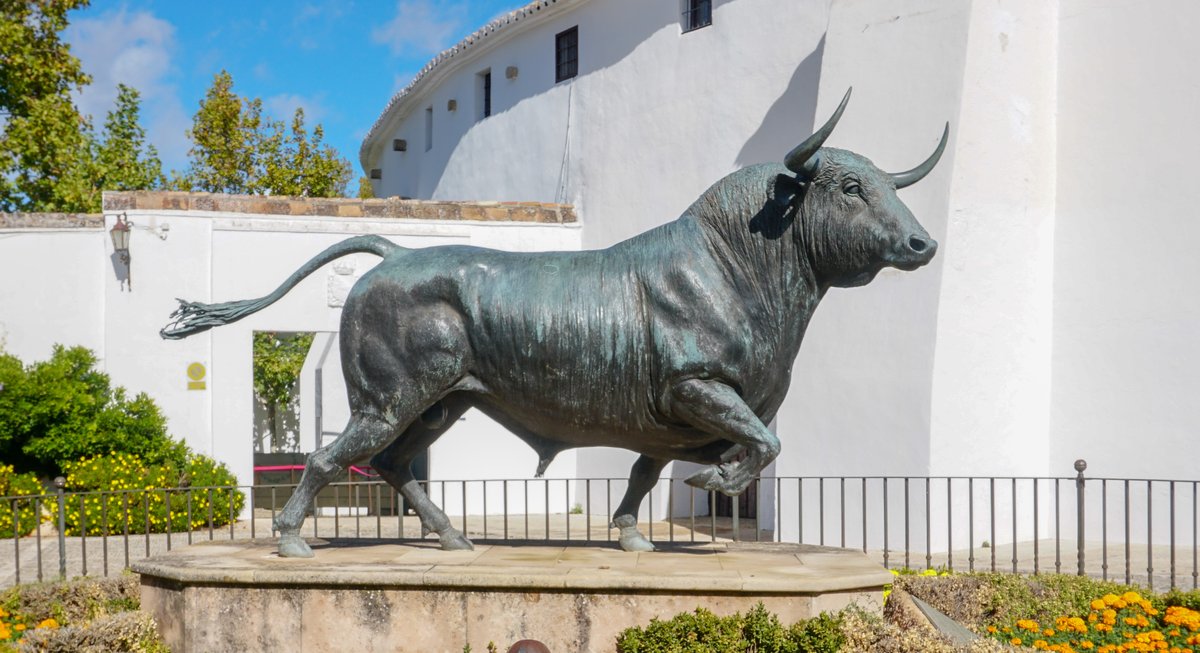
Monumento Al Toro De Lidia: Comprehensive Guide to Visiting Hours, Tickets, and Ronda’s Historical Sites
Date: 14/06/2025
Introduction
The Monumento Al Toro De Lidia in Ronda, Spain, is a striking tribute to the city’s storied bullfighting heritage and the enduring symbolism of the “toro bravo”—the Spanish fighting bull. Set near the historic Plaza de Toros, one of the oldest and most architecturally significant bullrings in Spain, the monument is more than a statue: it is a cultural landmark reflecting centuries of local pride, artistry, and evolving tradition. This detailed guide covers the monument’s origins, cultural significance, visiting hours, ticketing, accessibility, and practical tips for exploring Ronda’s broader historical landscape (Ronda Today; Nomads Travel Guide; Evendo).
Table of Contents
- Origins and Artistic Creation
- Historical Context: Ronda and Bullfighting
- Cultural Significance
- Visiting the Monument: Hours, Tickets & Accessibility
- The Monument in Contemporary Context
- Practical Visitor Information
- Frequently Asked Questions (FAQ)
- Ronda’s Must-See Historical Sites
- Conclusion and Travel Planning
Origins and Artistic Creation
The Monumento Al Toro De Lidia was inaugurated in 2005, commissioned by the city and the Real Maestranza de Caballería de Ronda. The impressive bronze sculpture stands near the entrance of the Plaza de Toros, greeting visitors with its realistic depiction of the fighting bull—a creature revered in Spanish culture for its strength and bravery. The monument’s plaque describes the bull as “a pillar of the festival, the culture, and the history of a town,” underscoring its foundational role in Ronda’s identity (Nomads Travel Guide).
Historical Context: Ronda and Bullfighting
Ronda’s association with bullfighting is legendary. The Plaza de Toros de Ronda, completed in 1785, is one of the oldest bullrings in the world and the birthplace of the “Ronda style” of bullfighting, where matadors face bulls on foot. The city is also the home of the famous Romero dynasty—including Pedro Romero, who revolutionized modern bullfighting in the 18th century. The Real Maestranza de Caballería de Ronda, established in 1485, continues to promote cultural and educational initiatives related to these traditions (Ronda Today; Explorial).
Cultural Significance
The fighting bull, or “toro de lidia,” is a potent symbol of Spanish valor, resilience, and rural heritage. The monument is a focal point during the Feria de Pedro Romero each September, a festival that celebrates Ronda’s bullfighting legacy with parades, music, and traditional Andalusian costumes. It serves as a site for reflection and debate, embodying both pride in local tradition and the evolving conversation about animal welfare and cultural change (Nomads Travel Guide).
Visiting the Monument: Hours, Tickets & Accessibility
Visiting Hours:
The monument is located in an open public plaza and is accessible 24 hours a day, 7 days a week, year-round. There are no barriers or restricted hours, allowing visitors to experience the site at any time (Evendo).
Tickets:
Admission to the monument is free—no tickets or reservations are required. Tickets are only necessary for entry to the adjacent Plaza de Toros and its Bullfighting Museum, which can be purchased at the venue or online. Typical museum hours are 10:00 AM to 6:00 PM, but these may vary seasonally.
Accessibility:
The area around the monument and bullring is pedestrian-friendly, with generally flat surfaces and ramps available. Some nearby streets have cobblestones or inclines reflecting Ronda’s historic character, but the site itself is accessible for most visitors, including those with wheelchairs.
The Monument in Contemporary Context
While the monument celebrates a cherished tradition, it also stands at the heart of Spain’s ongoing debate over bullfighting. As attitudes shift, particularly among younger generations and animal welfare advocates, the monument is being reframed as an educational and artistic landmark. It fosters dialogue about heritage, ethics, and the evolution of Spanish cultural identity (History Tools).
Practical Visitor Information
Location and Getting There
- Address: Plaza Teniente Arce, s/n, 29400 Ronda, Málaga, Spain
- By Car: Use the A-374 road; pay attention to parking restrictions in the city center.
- By Bus/Train: Ronda is well connected by bus and train from Málaga, Seville, and other Andalusian cities. The monument is a 15–20 minute walk from both the bus and train stations.
- By Foot: Ronda’s compact layout makes it ideal for walking. The monument is close to major sites like the Puente Nuevo and the Old Town.
Amenities
- Numerous cafes, tapas bars, and artisan shops surround the plaza.
- Public restrooms and accessible facilities are available nearby.
Tips for Visitors
- Best Time to Visit: Early morning or late afternoon for optimal lighting and fewer crowds.
- Photography: The monument is especially photogenic with Ronda’s dramatic cliffs and historic architecture in the background.
Frequently Asked Questions (FAQ)
Q: What are the Monumento Al Toro De Lidia visiting hours?
A: The monument is outdoors and accessible 24/7.
Q: Is there an admission fee?
A: No, the monument is free to visit. Tickets are required for the adjacent Plaza de Toros and museum.
Q: Are guided tours available?
A: Yes, many guided walking tours of Ronda include the monument, Plaza de Toros, and other key sites.
Q: Is the monument wheelchair accessible?
A: Yes, the plaza is generally accessible, though some surrounding streets may have uneven surfaces.
Q: Can I take photographs?
A: Absolutely—photography is encouraged, especially during golden hour.
Ronda’s Must-See Historical Sites
- Plaza de Toros de Ronda: One of Spain’s oldest bullrings, featuring a museum and guided tours (Explorial).
- Puente Nuevo: The iconic bridge spanning the El Tajo Gorge, with panoramic views and a small museum.
- Old Town (La Ciudad): Narrow cobbled streets, whitewashed houses, and the Mondragón Palace.
- Alameda del Tajo: Lush parklands and viewpoints near the bullring.
- Feria de Pedro Romero: Annual festival celebrating Ronda’s bullfighting and cultural traditions (Nomads Travel Guide).
Conclusion and Travel Planning
The Monumento Al Toro De Lidia is an essential stop for anyone exploring Ronda. It offers a window into the city’s layered history, vibrant traditions, and ongoing cultural conversations. With its 24/7 open access, central location, and free admission, the monument is both a cultural touchstone and an invitation to discover Ronda’s broader heritage. Pair your visit with other historical sites, sample local cuisine, and experience the rhythms of Andalusian life.
For real-time updates, museum hours, and ticket bookings, consult official tourism resources or the Evendo travel guide. Enhance your experience with the Audiala app and stay connected for the latest travel inspiration.
